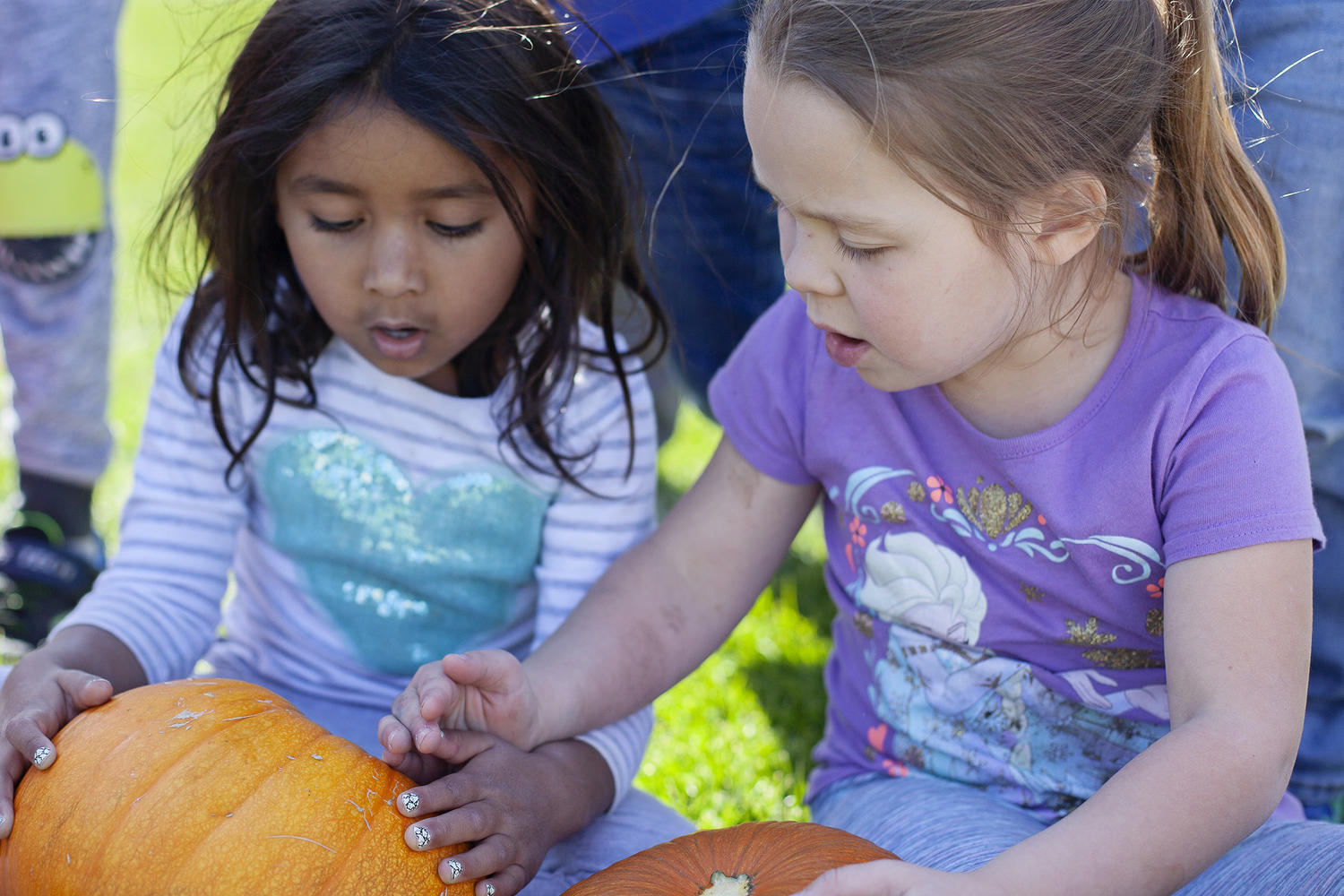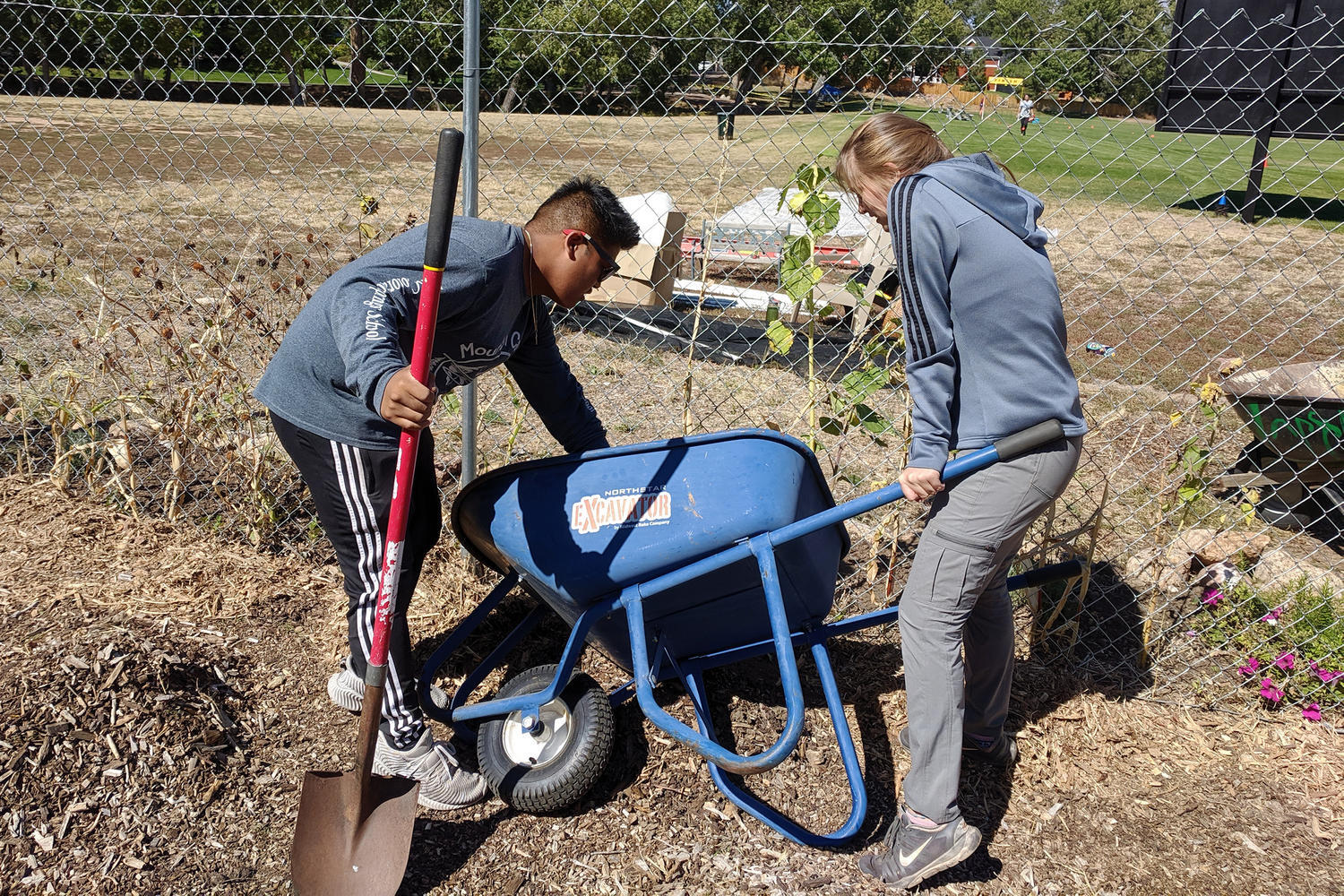When 4-year-old Olivia G. ’33 pulled carrots from the garden at The Colorado Springs School, it sparked a newfound interest in the veggie.
“She came home and told us all about it,” said her father, Nick Green. “She showed off her mini carrots and shared them and was proud of them. The garden is making a positive impact and teaching her where food comes from. She’s much more aware.”
Olivia ate carrots before she and her classmates in prekindergarten visited the garden in early September, but now she asks for them and points them out at the grocery store. She didn’t even mind the that ones from the garden were a bit dirty before her mother washed them.
“I love carrots,” Olivia said recently. “I love them so much. I think they are super good and fresh.” Her afternoon school snack that day? Carrots.
Igniting that curiosity and connection with nature is the goal behind the school’s new Adopt-a-Crop program, the first of its kind offered at CSS to the Children’s School in which students plant seeds and harvest the crops.
Upper School Science Teacher Natalie Hanson spearheaded the program because she sees an immense value in a school garden for a number of reasons.
“I’m thrilled to see so many teachers taking advantage of this resource. The physical, emotional and educational benefits of a school garden are being realized at CSS each time a student goes out there to pick a carrot, plant watermelon, or move plant waste to the compost pile,” Hanson said. “I’m excited to think of all the potential the garden holds if we continue to invest in and utilize it.”
The program kicked off last year when students in the Children’s School voted as a class on which crops they wished to plant and then matched up with one or two of their choice. Students planted starter seeds in their classrooms in the spring and helped care for them until they were transplanted in the spring to the garden near the athletic fields.
A variety of crops were planted, including pumpkins, zucchini, yellow squash, tomatoes, watermelon, basil and peppers. Faculty and staff helped water and care for the garden during the summer and into the fall.
Second graders harvested zucchini in late August and returned to the garden again in early October, the day before the first snow of the season.
“It felt like I was a farmer, working to save the watermelons so the cold wouldn’t ruin them. It would technically be a disaster if their stems freeze. We wanted to get all the tomatoes out of the school garden too,” said Clare J. ’30. “We didn’t have to worry about the vegetables underground like the potatoes and carrots because they would be safe from the cold. The dirt is like a blanket keeping them warm.”
After gathering crops, 2nd graders shouted a big thank you to Hanson, who often joins students while they harvest. “Thank you for helping with the school garden! Hanson told them. “Without your helping hands, this wouldn’t be possible.”
Even students who have already experienced growing food can appreciate the CSS garden.
“I have a garden at my house, and I grow lots of pumpkins and kale and most of the stuff here, but still, this is a pretty big garden, so it’s pretty great,” said 4th grader Bodi D. ’28.
Bodi and his classmates harvested zucchini, squash, and kale in early September. Their teacher, Sara Derr, baked treats for them with the zucchini.
“They were the best zucchini muffins I’ve ever had — the perfect amount of chocolate and the perfect amount of zucchini,” Quinn W. ’28 said.
Chef Allison Thompson served up some of the veggies in school lunches. Even Fred, the bearded dragon in Eric Gaylord’s middle school science classroom, has been fed from the garden after 4th graders delivered kale for him.
“It’s really cool to have a garden at our school because you can visit it and learn about what plants look like and get to see what bugs are on them — and you just get to explore it,” said 4th grader Giovanna R. “It’s really cool.”
Teachers relish in the children’s reactions to the garden. After students in prekindergarten harvested carrots, 3-year-old Ella S. ’34 held up hers and asked, “Did you know sun makes things grow?” Teacher Dawn Rainbowstar smiled before replying, “I did know that.”
As kindergarteners carried pumpkins to their classroom earlier this month, Maanya M. ’32 said, “I thought we were just growing green plants, but they turned into pumpkins. That was a surprise.”
In class, kindergarteners have been lining up the pumpkins by size. Teachers plan to cut open a few of the pumpkins for students to compare; for example, do the green unripened pumpkins look the same on the inside as the orange ripened ones? The class will roast the seeds.
“The garden teaches children about the life cycle of a plant and also important lessons in responsibility, patience, and perseverance,” Kindergarten Teacher Jolly Cunha said. “The kindergartners’ expressions of joy and wonder at seeing the fruits of their labor are priceless.”
The snow in early October damaged some of the plants that were still producing, but Hanson expects the kale and root vegetables will keep growing. She hopes to purchase frost blankets for next year so students can harvest into the winter.
The school’s Green Team, an Upper School club that promotes environmentalism through sustainability and eco-awareness, helps maintain the garden. Soon the club will put the beds to sleep for winter and build a second composter. Member Kylie C. ’20 is proud to be part of a project that is growing with the help of committed students.
“I think it’s meaningful that the garden is incorporated into the Green Team as a way the club can connect with the environment,” said Kylie, who also helped at the garden on service day this month by weeding, planting new mulch, and building hail covers to protect the vegetables. “It’s good to see what we can do as a team, especially considering that we want to positively impact the environment, and a garden is a really simple way to do it.”
Perhaps garden projects such as installing irrigation, incorporating art, or adding a meditation space are in the future. Hanson is hopeful the new hail netting will mean a larger fall harvest next year that can supply more food to the school kitchen or become a source of revenue that is reinvest into the garden.
“I’m also hoping that more classes will be able to integrate the garden into their lessons and activities and collaborate with me on ideas for new projects that will involve the children,” Hanson said.
CSS families interested in assisting with the garden or donating materials (such as wood chip mulch, gardening tools, frost covers, and specific building supplies) may contact Hanson at nhanson@css.org.
This is the second story in an ongoing series about the CSS garden. Read the first story here.














